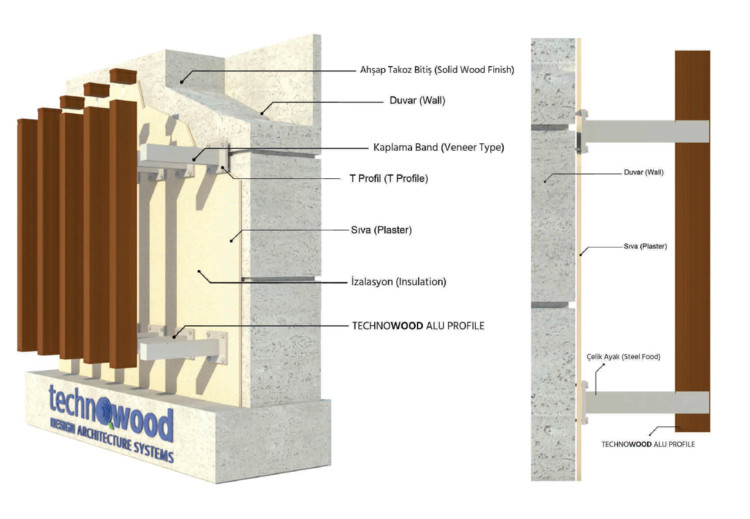
For many, the aesthetics of wood are powerfully enchanting. With a huge diversity of species and innumerable variations in colors, weights, and textures, wood is one of the most highly appreciated materials of all time. But the unrestrained logging of forests for use in construction has had and will continue to have enormous environmental impacts if precautions such as sustainable management, legitimate certification, or reforestation are not taken. Being an organic material, when used for construction, wood tends to morph under conditions of humidity, heat, and loads, and its fibers eventually deform over time. In addition, wood is a material that does not respond well to environments where it is soaked and dried repeatedly, which can cause it to rot after some time if it is not adequately waterproofed. Therefore, there are some situations where using wood may not be a good idea.

However, there exist several material options that maintain the aesthetics of wood, but are structured or combined with materials such as aluminum. This is the case with Technowood, which works well for uses that wood may not be as suitable for - including applications with high weather exposure or overly thin parts. The material consists of a natural wood blade about 0.5 mm thick and coated with GRP (fiberglass reinforced polyester) on aluminum profiles or sheets. The following paragraphs highlight the benefits and possibilities of this technology:
Aluminum components are generally extremely lightweight, and even very thin or slender parts show no bending, stability changes, or cracking over time. Thus, they can be used in facades without being overloaded, and can be supported by simple T-profiles. Another advantage of the material is that, unlike natural wood, there is little need for attention and very low maintenance costs, remaining highly resistant to even the most demanding conditions such as intense sun or high humidity.

It is important to note that, even with wood in its composition, Technowood products do not represent any additional risk when exposed to high temperatures and fires. In five different fire tests in Europe (EN13501-1), USA (ASTM E84, UL 723 and NFPA 259) and Russia (GOST 30244-94), the material performed optimally, being classified as class A. This means that it is a low-combustible material, with a very low contribution to fire, without causing flashover. Therefore, it is a material that can be used quietly in closed environments where fire resistant items are needed, such as hospital corridors and even in escape areas.

Other issues that generally restrict the use of wood are the infinite possibilities of shapes that profiles and panels can receive, in addition to allowing pieces up to 12 meters in length. and they are parts immune to attacks by insects and fungi. The possibilities for using Technowood are:
Facade profiles
Profiles are used to create pergolas or façade areas where visual permeability is desired, usually installed detached from the outer wall. The four surfaces of the profiles are clad in wood, and the pieces can reach up to 7.5 meters in length, a measure that would be practically impossible to achieve with just one piece of solid wood.


Panels Systems
Façade panels are plates bolted to T-profiles, and can receive different coating options, dimensions, and arrangements.


Click Façade System
Aluclick profiles consist of profiles that are installed separately as click on vertical profiles. They are very similar to façade profiles, but are installed glued down. Therefore, these parts are usually coated on 3 of the 4 faces.


Siding Façade System
This system would be equivalent to wooden board cladding, with profiles 10, 15, or 20 centimeters wide, with different forms of connections to each other. They can also be used for linings.


Sunshade Systems
Shading elements, vertical or horizontal, can be manufactured at Technowood. By default, the blade profiles are produced in square, rectangular, click, and ellipse shapes, and can be up to 7.5 meters long.


Pergola-Systems
When the intention is to create a filtered shade for gardens in summer, offering semi-open spaces that can receive vegetation, pergolas can also be built using this material.


Interior panels
For those hoping to create a warm, rustic interior through natural tones of wood, there are options to use interior panels, which are also structured by metal T profiles.

Although wood can be considered a renewable resource if it is used thoughtfully and sustainably, we know that a considerable part of Earth's forests have already been lost. Therefore, it is a pertinent choice to use wood only where it is really suitable and can last indefinitely. For applications where wood would not be reasonably durable, Technowood may be a good option, as it uses 98% fewer trees to produce its products than solid wood. Considering ways to make buildings more durable and efficient is always a good idea. In 2019 the product received the ICONIC Award from the “German Design Council”, as an Innovative Material.

